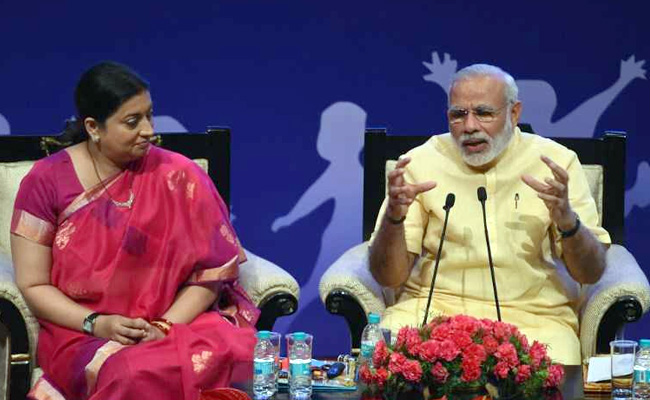Fake news order: What Smriti Irani did not learn from Rajiv Gandhi, Vasundhara Raje

IndiaToday.in
New Delhi
April 4, 2018
 In view of the Pope's Message for World Communication Day to be celebrated on Sunday 13th May 2018, especially on Fake News, this India Today report is of great significance. The theme of Pope Francis' message (reproduced at the end) is “The truth will set you free” (Jn 8:32). Fake news and journalism for peace. Readers will find that this India Today report and the Pope's World Communication Day message have several similarities. But does it mean the Church allows a free press? Certainly not, as many reports by the Laity are not published in Church journals / newsletters. In spite of the Vatican's official stand on Social Communications, the high and mighty Bishops and Cardinals of the Indian Church does not believe in two-way communication. By not even acknowledging communications from the Laity, they affirm the impression that they do not believe in any communication, except monologues or one-way traffic i.e. terse messages from their end. The Vatican II documents Inter Mirifica (Decree on the Means of Social Communication – 1963), Communio et Progressio (1971) and Aetatis Novae (1992), make it abundantly clear that the Church gives utmost importance to Social Communications, i.e. all types and ways of communicating in human society – from traditional forms like storytelling, creative art, drama, dance and music to traditional print and electronic media, and new media including the web, blogs and social networks. Isaac Gomes, Asso. Editor, Church Citizens' Voice.
In view of the Pope's Message for World Communication Day to be celebrated on Sunday 13th May 2018, especially on Fake News, this India Today report is of great significance. The theme of Pope Francis' message (reproduced at the end) is “The truth will set you free” (Jn 8:32). Fake news and journalism for peace. Readers will find that this India Today report and the Pope's World Communication Day message have several similarities. But does it mean the Church allows a free press? Certainly not, as many reports by the Laity are not published in Church journals / newsletters. In spite of the Vatican's official stand on Social Communications, the high and mighty Bishops and Cardinals of the Indian Church does not believe in two-way communication. By not even acknowledging communications from the Laity, they affirm the impression that they do not believe in any communication, except monologues or one-way traffic i.e. terse messages from their end. The Vatican II documents Inter Mirifica (Decree on the Means of Social Communication – 1963), Communio et Progressio (1971) and Aetatis Novae (1992), make it abundantly clear that the Church gives utmost importance to Social Communications, i.e. all types and ways of communicating in human society – from traditional forms like storytelling, creative art, drama, dance and music to traditional print and electronic media, and new media including the web, blogs and social networks. Isaac Gomes, Asso. Editor, Church Citizens' Voice.
After massive outrage from media and the Opposition, the Ministry of Information and Broadcasting withdrew its contentious guidelines to penalise journalists for fake news. The decision to withdraw the orders came on the directions of Prime Minister Narendra Modi.
The guidelines issued by the Smriti Irani's Ministry of Information and Broadcasting, on Monday night, had said that a complaint on fake news in print media would be sent to the Press Council of India and in electronic media to the News Broadcasters Association.
Once the publication or telecast of fake news was confirmed, accreditation of a journalist would be suspended for six months in case of first violation, for a year in case of second violation, and permanently for the third time.
The guidelines, however, were termed by journalists and the Opposition as an attempt to "muzzle" the free press. In less than 24 hours, the guidelines were withdrawn.
This, however, is not the first time when free press has come under attack from the government. In the past too, similar attempts to gag the media were made and then contentious orders were withdrawn following widespread criticism.
THE INFAMOUS PRESS BILL OF BIHAR
The Bihar Press Bill, pushed through by then Bihar chief minister Jagannath Mishra, was dubbed a "black bill", a "draconian law" and a device "designed to derail democratic functioning". The infamous bill was passed by the Bihar Assembly on July 31, 1982 in a matter of five minutes.
The bill brought in amendments to Section 292 of the Indian Penal Code (IPC) and Section 455 of the Criminal Procedure Code (CrPC). The IPC amendment gave the state government powers to prevent the printing and publishing of "grossly indecent or scurrilous matter or matters intended for blackmail". The CrPC amendment made the offence cognisable and non-bailable.
A year later, the bill was withdrawn. In an interview to ANI last year, Jagannath Mishra said that the Press Bill was "not intended to suppress the voice of the press, but it was in public interest". "But considering the intensity of the protest, we surrendered to people's rights and withdrew the bill," the former Bihar chief minister said.
Jagannath Mishra said that then prime minister Indira Gandhi was "upset with reports published in the newspaper about her differences with Maneka Gandhi" and was "really disturbed". "So, I got the hint of introducing the Press Bill," he said.
RAJIV GANDHI'S GOVERNMENT'S DEFAMATION BILL
In July 1988, the Rajiv Gandhi government at the Centre introduced a Defamation Bill in Lok Sabha. The government was hit with allegations regarding the Bofors scandal and the elections will just a year away.
The bill, passed in the Lok Sabha, was withdrawn two months later after protests by media which called the bill an instrument to bludgeon free speech.
In tone and tenor, the Defamation Bill was similar to the Bihar Press Bill and sought to create new categories of offences under "scurrilous" writings and "criminal imputation".
The Rajiv Gandhi government's statement on withdrawing the Bill read, "A free press is an integral part of the inner strength and dynamism of our democracy. Without a free press there can be no democracy. The imperishable values of our freedom struggle have gone into the making of the press in India. We uphold this legacy."
VASUNDHARA RAJE'S MEDIA GAG BILL
Last year, the Vasundhara Raje government in Rajasthan brought in the Criminal Laws (Rajasthan Amendment) Ordinance 2017 which sought to protect serving and former judges, magistrates and public states in the state from being investigated for on-duty action, without the state government's prior sanction.
The controversial ordinance barred the media from reporting on such accusations till the government sanctioned a probe. The ordinance said that anyone revealing the name and identity of an official against whom a case for an FIR has been filed would face imprisonment for two years.
The ordinance was promulgated by the Rajasthan government on September 6, 2017, and the Bill was introduced in the Assembly on October 23, 2017. The ordinance was criticised by media, including the Editors' Guild.
In February this year, the government announced that it is withdrawing the controversial Bill. "We referred the Bill to the Select Committee, we allowed the ordinance to get lapsed and when it is not a law yet, then what should we withdraw? However, we are taking the Bill back from the Select Committee," Raje said.
As per NDTV 3 April 2018 report captioned
PM Modi Overrules Smriti Irani, Cancels "Fake News" Order: 10 Points
Here is your 10-point cheat sheet to this big story:
1. The Prime Minister's Office also said the question of checking fake news should be left to media watchdog Press Council of India.
2. Here's why Smriti Irani's move triggered such a backlash. The need to stop fake news is widely acknowledged, but the order said that any complaint against a journalist accused of running fake news meant that their government accreditation would be immediately suspended.
3. The two main regulatory bodies for the print and broadcast media would have 15 days to decide whether the journalist was guilty.
4. Senior editors said the move was designed to give the government more control over the news. They said suspending a journalist's access to government events and news conferences before the inquiry against them was completed was unfair. Journalists also questioned the deadline for the inquiry because it was decided without consulting those who regulate print and TV media.
5. The Editors Guild of India, strongly condemning the fake news order, said, "The Guild acknowledges the intervention of the Prime Minister's Office to withdraw the I & B Ministry's notification but remains deeply disturbed that faith continues to be reposed on the Press Council of India to deliver justice on such issues. The recent reconstitution of the Press Council of India has been done in a manner that gives rise to doubts over the independence of the institution and its ability to play neutral umpire."
6. The ministry did not define "fake news" but said complaints about it in print would be referred for determination to the Press Council of India, with suspected cases on television going to the National Broadcasters Association.
7. Shekhar Gupta, a former editor of the Indian Express newspaper, said it was "a breathtaking assault on mainstream media", and urged journalists to resist it.
8. Congress leader Ahmed Patel questioned whether the guidelines were aimed at preventing journalists from reporting news uncomfortable to the establishment.
9. "What is guarantee that these rules will not be misused to harass honest reporters? Is it not possible that motivated complaints will be filed to suspend accreditation until enquiry is on?" Ahmed Patel tweeted.
10. Smriti Irani responded: "Glad to see you awake Ahmed Patel ji. Whether a News article / broadcast is fake or not will be determined by PCI & NBA; both of whom I'm sure you know are not controlled/ operated by GOI."
In connection with the above reports, readers would do well to connect them with Pope Francis' World Communication Day 2018 message below:
MESSAGE OF HIS HOLINESS POPE FRANCIS
FOR WORLD COMMUNICATIONS DAY
13th May 2018
(Message released on 24 January 2018)
“The truth will set you free” (Jn 8:32).
Fake news and journalism for peace
Dear Brothers and Sisters,
Communication is part of God’s plan for us and an essential way to experience fellowship. Made in the image and likeness of our Creator, we are able to express and share all that is true, good, and beautiful. We are able to describe our own experiences and the world around us, and thus to create historical memory and the understanding of events. But when we yield to our own pride and selfishness, we can also distort the way we use our ability to communicate. This can be seen from the earliest times, in the biblical stories of Cain and Abel and the Tower of Babel (cf. Gen 4:4-16; 11:1-9). The capacity to twist the truth is symptomatic of our condition, both as individuals and communities. On the other hand, when we are faithful to God’s plan, communication becomes an effective expression of our responsible search for truth and our pursuit of goodness.
In today’s fast-changing world of communications and digital systems, we are witnessing the spread of what has come to be known as “fake news”. This calls for reflection, which is why I have decided to return in this World Communications Day Message to the issue of truth, which was raised time and time again by my predecessors, beginning with Pope Paul VI, whose 1972 Message took as its theme: “Social Communications at the Service of Truth”. In this way, I would like to contribute to our shared commitment to stemming the spread of fake news and to rediscovering the dignity of journalism and the personal responsibility of journalists to communicate the truth.
1. What is “fake” about fake news?
The term “fake news” has been the object of great discussion and debate. In general, it refers to the spreading of disinformation on line or in the traditional media. It has to do with false information based on non-existent or distorted data meant to deceive and manipulate the reader. Spreading fake news can serve to advance specific goals, influence political decisions, and serve economic interests.
The effectiveness of fake news is primarily due to its ability to mimic real news, to seem plausible. Secondly, this false but believable news is “captious”, inasmuch as it grasps people’s attention by appealing to stereotypes and common social prejudices, and exploiting instantaneous emotions like anxiety, contempt, anger and frustration. The ability to spread such fake news often relies on a manipulative use of the social networks and the way they function. Untrue stories can spread so quickly that even authoritative denials fail to contain the damage.
The difficulty of unmasking and eliminating fake news is due also to the fact that many people interact in homogeneous digital environments impervious to differing perspectives and opinions. Disinformation thus thrives on the absence of healthy confrontation with other sources of information that could effectively challenge prejudices and generate constructive dialogue; instead, it risks turning people into unwilling accomplices in spreading biased and baseless ideas. The tragedy of disinformation is that it discredits others, presenting them as enemies, to the point of demonizing them and fomenting conflict. Fake news is a sign of intolerant and hypersensitive attitudes, and leads only to the spread of arrogance and hatred. That is the end result of untruth.
2. How can we recognize fake news?
None of us can feel exempted from the duty of countering these falsehoods. This is no easy task, since disinformation is often based on deliberately evasive and subtly misleading rhetoric and at times the use of sophisticated psychological mechanisms. Praiseworthy efforts are being made to create educational programmes aimed at helping people to interpret and assess information provided by the media, and teaching them to take an active part in unmasking falsehoods, rather than unwittingly contributing to the spread of disinformation. Praiseworthy too are those institutional and legal initiatives aimed at developing regulations for curbing the phenomenon, to say nothing of the work being done by tech and media companies in coming up with new criteria for verifying the personal identities concealed behind millions of digital profiles.
Yet preventing and identifying the way disinformation works also calls for a profound and careful process of discernment. We need to unmask what could be called the "snake-tactics" used by those who disguise themselves in order to strike at any time and place. This was the strategy employed by the "crafty serpent" in the Book of Genesis, who, at the dawn of humanity, created the first fake news (cf. Gen 3:1-15), which began the tragic history of human sin, beginning with the first fratricide (cf. Gen 4) and issuing in the countless other evils committed against God, neighbour, society and creation. The strategy of this skilled "Father of Lies" (Jn 8:44) is precisely mimicry, that sly and dangerous form of seduction that worms its way into the heart with false and alluring arguments.
In the account of the first sin, the tempter approaches the woman by pretending to be her friend, concerned only for her welfare, and begins by saying something only partly true: "Did God really say you were not to eat from any of the trees in the garden?" (Gen 3:1). In fact, God never told Adam not to eat from any tree, but only from the one tree: "Of the tree of the knowledge of good and evil you are not to eat" (Gen 2:17). The woman corrects the serpent, but lets herself be taken in by his provocation: "Of the fruit of the tree in the middle of the garden God said, “You must not eat it nor touch it, under pain of death" (Gen 3:2). Her answer is couched in legalistic and negative terms; after listening to the deceiver and letting herself be taken in by his version of the facts, the woman is misled. So she heeds his words of reassurance: "You will not die!" (Gen 3:4).
The tempter’s “deconstruction” then takes on an appearance of truth: "God knows that on the day you eat it your eyes will be opened and you will be like gods, knowing good and evil" (Gen 3:5). God’s paternal command, meant for their good, is discredited by the seductive enticement of the enemy: "The woman saw that the tree was good to eat and pleasing to the eye and desirable" (Gen 3:6). This biblical episode brings to light an essential element for our reflection: there is no such thing as harmless disinformation; on the contrary, trusting in falsehood can have dire consequences. Even a seemingly slight distortion of the truth can have dangerous effects.
What is at stake is our greed. Fake news often goes viral, spreading so fast that it is hard to stop, not because of the sense of sharing that inspires the social media, but because it appeals to the insatiable greed so easily aroused in human beings. The economic and manipulative aims that feed disinformation are rooted in a thirst for power, a desire to possess and enjoy, which ultimately makes us victims of something much more tragic: the deceptive power of evil that moves from one lie to another in order to rob us of our interior freedom. That is why education for truth means teaching people how to discern, evaluate and understand our deepest desires and inclinations, lest we lose sight of what is good and yield to every temptation.
3. "The truth will set you free" (Jn 8:32)
Constant contamination by deceptive language can end up darkening our interior life. Dostoevsky’s observation is illuminating: "People who lie to themselves and listen to their own lie come to such a pass that they cannot distinguish the truth within them, or around them, and so lose all respect for themselves and for others. And having no respect, they cease to love, and in order to occupy and distract themselves without love they give way to passions and to coarse pleasures, and sink to bestiality in their vices, all from continual lying to others and to themselves.” (The Brothers Karamazov, II, 2).
So how do we defend ourselves? The most radical antidote to the virus of falsehood is purification by the truth. In Christianity, truth is not just a conceptual reality that regards how we judge things, defining them as true or false. The truth is not just bringing to light things that are concealed, "revealing reality", as the ancient Greek term aletheia (from a-lethès, "not hidden") might lead us to believe. Truth involves our whole life. In the Bible, it carries with it the sense of support, solidity, and trust, as implied by the root 'aman, the source of our liturgical expression Amen. Truth is something you can lean on, so as not to fall. In this relational sense, the only truly reliable and trustworthy One – the One on whom we can count – is the living God. Hence, Jesus can say: "I am the truth" (Jn 14:6). We discover and rediscover the truth when we experience it within ourselves in the loyalty and trustworthiness of the One who loves us. This alone can liberate us: "The truth will set you free" (Jn 8:32).
Freedom from falsehood and the search for relationship: these two ingredients cannot be lacking if our words and gestures are to be true, authentic, and trustworthy. To discern the truth, we need to discern everything that encourages communion and promotes goodness from whatever instead tends to isolate, divide, and oppose. Truth, therefore, is not really grasped when it is imposed from without as something impersonal, but only when it flows from free relationships between persons, from listening to one another. Nor can we ever stop seeking the truth, because falsehood can always creep in, even when we state things that are true. An impeccable argument can indeed rest on undeniable facts, but if it is used to hurt another and to discredit that person in the eyes of others, however correct it may appear, it is not truthful. We can recognize the truth of statements from their fruits: whether they provoke quarrels, foment division, encourage resignation; or, on the other hand, they promote informed and mature reflection leading to constructive dialogue and fruitful results.
4. Peace is the true news
The best antidotes to falsehoods are not strategies, but people: people who are not greedy but ready to listen, people who make the effort to engage in sincere dialogue so that the truth can emerge; people who are attracted by goodness and take responsibility for how they use language. If responsibility is the answer to the spread of fake news, then a weighty responsibility rests on the shoulders of those whose job is to provide information, namely, journalists, the protectors of news. In today’s world, theirs is, in every sense, not just a job; it is a mission. Amid feeding frenzies and the mad rush for a scoop, they must remember that the heart of information is not the speed with which it is reported or its audience impact, but persons. Informing others means forming others; it means being in touch with people’s lives. That is why ensuring the accuracy of sources and protecting communication are real means of promoting goodness, generating trust, and opening the way to communion and peace.
I would like, then, to invite everyone to promote a journalism of peace. By that, I do not mean the saccharine kind of journalism that refuses to acknowledge the existence of serious problems or smacks of sentimentalism. On the contrary, I mean a journalism that is truthful and opposed to falsehoods, rhetorical slogans, and sensational headlines. A journalism created by people for people, one that is at the service of all, especially those – and they are the majority in our world – who have no voice. A journalism less concentrated on breaking news than on exploring the underlying causes of conflicts, in order to promote deeper understanding and contribute to their resolution by setting in place virtuous processes. A journalism committed to pointing out alternatives to the escalation of shouting matches and verbal violence.
To this end, drawing inspiration from a Franciscan prayer, we might turn to the Truth in person:
Lord, make us instruments of your peace.
Help us to recognize the evil latent in a communication that does not build communion.
Help us to remove the venom from our judgements.
Help us to speak about others as our brothers and sisters.
You are faithful and trustworthy; may our words be seeds of goodness for the world:
where there is shouting, let us practise listening;
where there is confusion, let us inspire harmony;
where there is ambiguity, let us bring clarity;
where there is exclusion, let us offer solidarity;
where there is sensationalism, let us use sobriety;
where there is superficiality, let us raise real questions;
where there is prejudice, let us awaken trust;
where there is hostility, let us bring respect;
where there is falsehood, let us bring truth.
Amen.
Francis
















